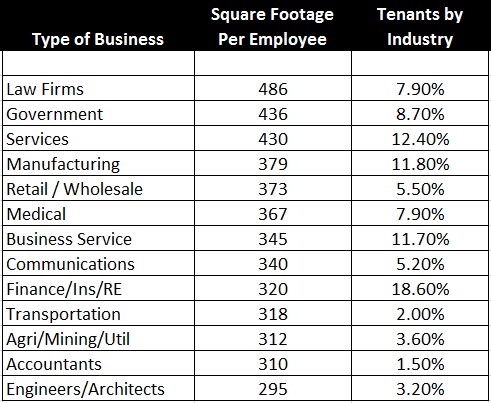
How Much Office Space Do We Really Need? 4 Critical Factors to Consider
A surprisingly complicated question rears its head anytime a company goes out to lease or purchase an office building:
How much office space do we need?
Well, there are a number of factors that should affect your decision—some are more obvious than others.
Here, we want to highlight the five most important:
1) Your Industry
Easily the most fundamental of anything on our list, your company’s industry determines the kind of space you need.
For example, law firms are traditionally filled with large conference and meeting areas, large partner’s offices, and a high ratio of attorneys (large offices) to administrative positions (open cubicle areas).
On the other hand, many engineers and architects pack their personnel into cubicles and use space as efficiently as you might expect from these professions. As you’ll see below, these firms take the trophy for fewest square feet per person.
Now you don’t necessarily have to conform to the norm in your industry. Take your company for what it is: it’s own unique entity. If that means going against the grain, so be it.
2) Your Culture
Internal harmony is essential to the success of any organization.
That’s why some law firms are as space efficient as engineers and some CPA firms resemble law offices.
In the end, the “exception” is the “rule”. Stick with what has made your company profitable instead of conforming to the latest trends just to make your space planner or broker happy.
It’s important that you respect your company’s identity—down to the space you occupy.
In fact, the space your company occupies can help to define your identity.
Still, there is more context that needs sorting out before you can come to a decision.
3) Your Trajectory
Not only should you look at company’s past branding, but also its future growth potential.
In the tenant’s market from 20082013, it was common to see landlords include extra space in a tenant’s premises without making them pay for it until months or years down the road.
In today’s landlord’s market, you’re far less likely to find this phenomenon.
Ironically, many companies need as much room to expand as possible in the growing economy.
The result is tension based on size of premises and initial lease term length. This sets the stage for some of the most common leasing mistakes businesses make.
Remember to prioritize your needs, but never forget to properly inspect prospective locations before you make a decision.
4) The Space Itself
Commercial real estate might not have as much variance as commercial businesses do, but it’s pretty close.
Various aspects of design—such as space efficiency or the utility setup—can vary drastically between different buildings or even floor plans in the same building.
Consider what “square foot” means in any property you’re surveying.
Most multitenant environments quote square footage based on “rentable square feet” while the average consumer thinks in terms of “usable square feet”. The difference is that a rentable quote includes common areas that every occupant uses.
That means lifts, lobbies, and lavatories all count against you. The ratio is typically expressed as a load factor, and can vary from as little as 5% to as much as 30%. Most office owners use a figure of 15% even if their actual factor is much higher simply because the market won’t support a 30% premium.
To put things plainly:
If you need to use 10,000 square feet, you’ll be renting or buying 115% that amount—11,500 rentable square feet.
Once you understand this fact, those 6 foot wide hallways and 14 foot deep offices sound a bit less attractive. The same could be said for knocking down walls or relocating bathrooms.
What is always most important is that you choose a space that fulfills the unique needs of your business.
***
The key is to focus on your business and its industry first. That way you’ll be less likely to become overwhelmed or lead astray by the bells and whistles of any particular property.
Choosing the correct office space is a critical decision for businesses young and old.
Here, we’ve provided some of our best insights into how you should go about making that selection.

